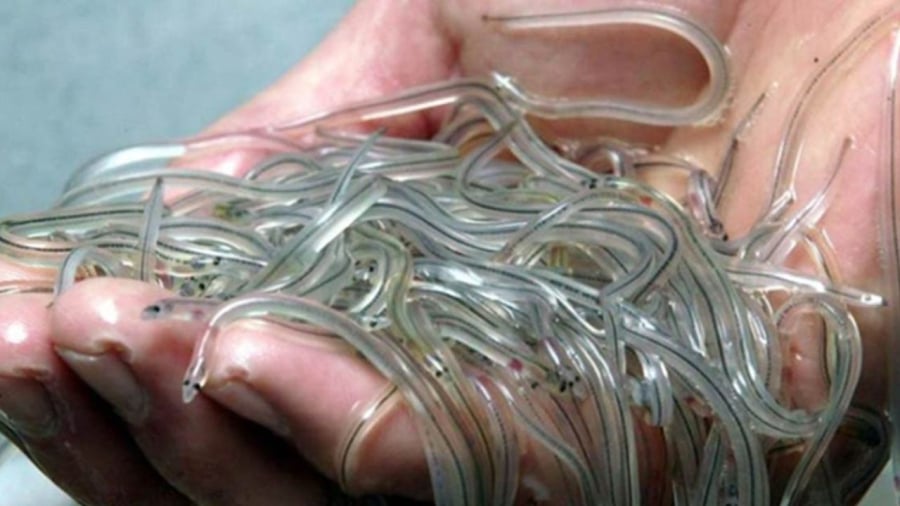The diverse and fascinating world of marine life never ceases to amaze, and one such creature that often leaves people in awe is the glass eel, or lươn thủy tinh in Vietnamese. Beyond their striking transparent appearance, these eels hold intriguing secrets about their survival, migration, and ecological significance. Let’s delve into the captivating world of these unique sea creatures.
What are Glass Eels?
Glass eels refer to the juvenile stage of certain freshwater eel species, notably the European eel (Anguilla anguilla) and the Japanese eel (Anguilla japonica). This phase marks the transition from the leptocephalus larva to young eels, typically occurring after an extensive ocean migration of thousands of kilometers from their spawning grounds to freshwater habitats.

As their name suggests, glass eels are known for their elongated, translucent bodies, almost entirely see-through, offering a glimpse of their spine and internal organs. This distinctive feature earns them the moniker “glass eel” or “crystal eel.”
Morphological and Biological Characteristics
Size: Glass eels measure around 6-8 cm in length when they first arrive at river mouths. They continue to grow, and their skin gradually becomes more opaque as they adapt to freshwater conditions.
Shape: Glass eels have flat and slender bodies, devoid of pelvic fins, and possess pointed tails. Their eyes are relatively large in proportion to their body size.
Coloration: Lacking significant skin pigmentation, their transparent bodies serve as an effective camouflage mechanism in both marine and freshwater environments, making it difficult for predators to spot them.
Lifespan: As they mature into adult eels, their lifespan can range from 10 to 20 years, depending on environmental conditions.
The Enigmatic Migration Journey
One of the most intriguing aspects of glass eels is their complex life cycle and reproductive migration. For instance, the European eel spawns in the Sargasso Sea in the Atlantic Ocean. After hatching, the larvae drift with ocean currents for 6,000-7,000 kilometers over 6-12 months before reaching the coasts of Europe.
Upon arrival, they metamorphose into glass eels and commence their journey upstream into rivers and streams, where they reside for several years before migrating back to the ocean to spawn, thus completing a mysterious life cycle that remains only partially understood by scientists.

Ecological and Economic Significance
Glass eels play a crucial role in aquatic food chains. They serve as prey for larger fish, seabirds, and other predators, while also contributing to the ecological balance in estuarine and freshwater ecosystems.
However, glass eels are also highly prized in the commercial market, particularly in Japan, South Korea, and China, where they are cultivated to become adult eels for culinary purposes, especially the renowned unagi dish in Japanese cuisine.
In Japan, glass eels have fetched prices as high as $3,000-$5,000 per kilogram, equivalent to 70-120 million VND per kilogram. On the black market, these prices can soar even higher due to the banning of their exploitation in several European countries.
In France, retail prices for individual glass eels can range from €3-€5 each, translating to a staggering €30,000-€60,000 per kilogram if sold individually.
The high demand and declining natural supply have fueled excessive fishing and even international smuggling of glass eels, leading to the classification of the European eel as an endangered species by the IUCN.
Threats to Glass Eels
- Environmental pollution: Deteriorating water quality in estuaries and inland rivers hinders the survival and development of young eels.
- Hydroelectric dams and water barriers: These structures obstruct the natural migration route of glass eels from the ocean to freshwater habitats.
- Overexploitation: Rampant fishing to meet market demands has led to a decline in their population.
- Climate change: Alterations in ocean currents, sea temperatures, and food sources indirectly impact the survival of glass eels.
Glass eels are not just intriguing creatures with a unique appearance, but they also serve as a testament to the wonders of nature and the intricate life cycles that remain to be fully uncovered. By understanding and appreciating these small yet significant creatures, we take the first step toward valuing and preserving the treasures of our oceans.
Nha Trang Oceanography Museum – A Captivating Miniature Ocean in the Heart of the City
Uncover the enchanting Nha Trang Oceanography Institute – the vibrant heart of the ocean, housing over 23,000 marine specimens and a mesmerizing humpback whale skeleton. This institute promises an exhilarating journey of discovery for all visitors, offering a unique glimpse into the wonders of marine life.































